SEO
The Rise, Fall, & Future

Linktree’s organic growth has been impressive over the last few years, but its organic traffic has dipped recently. What’s changed?
Let’s find out.
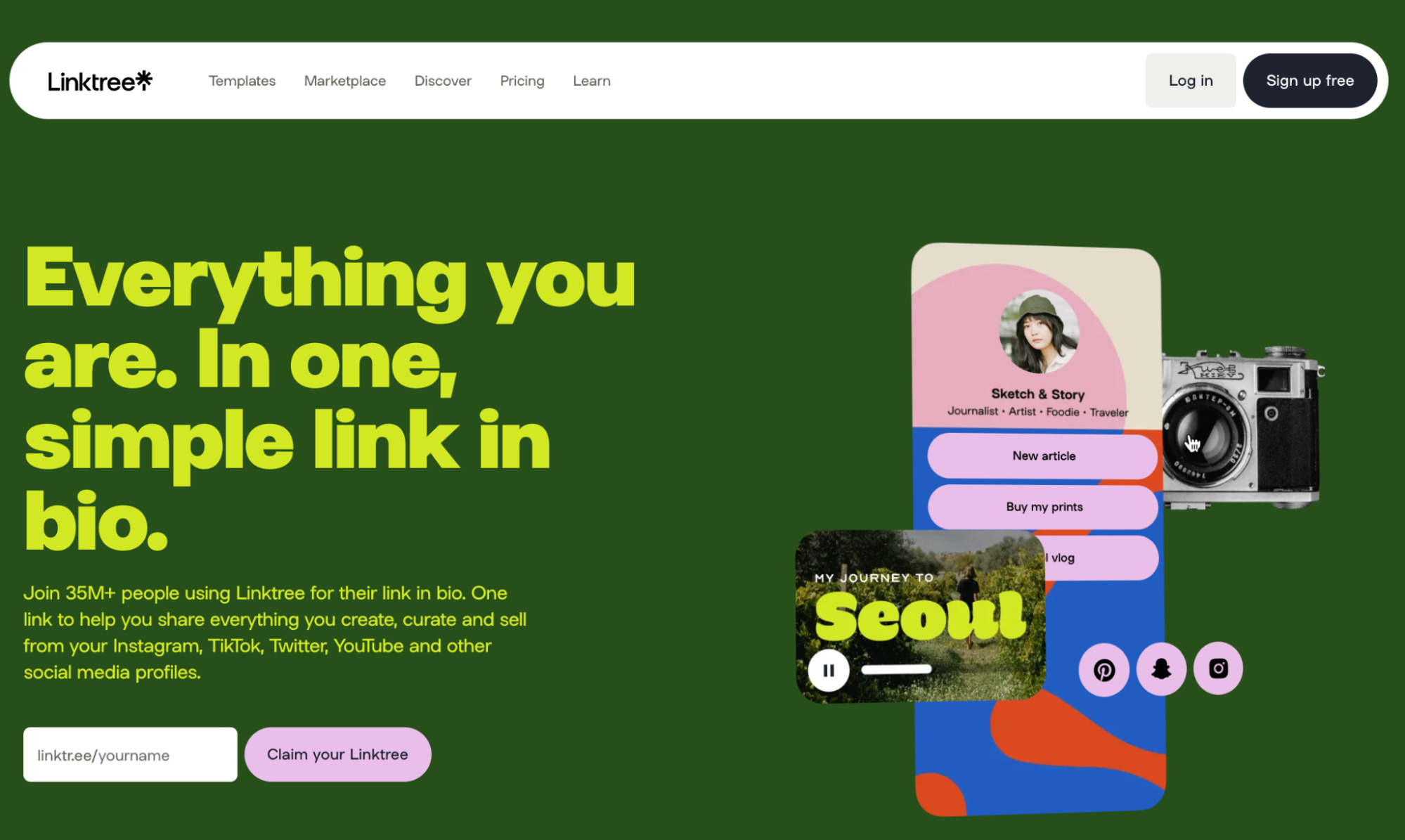
Linktree says it has over 35 million users.
It built its brand by creating a platform where content creators can share multiple links to their social media accounts or websites through a single bio page.
According to Ahrefs’ Site Explorer, the website receives ~2.7 million monthly organic traffic and has a Domain Rating (DR) of 93, making it a high-authority site.
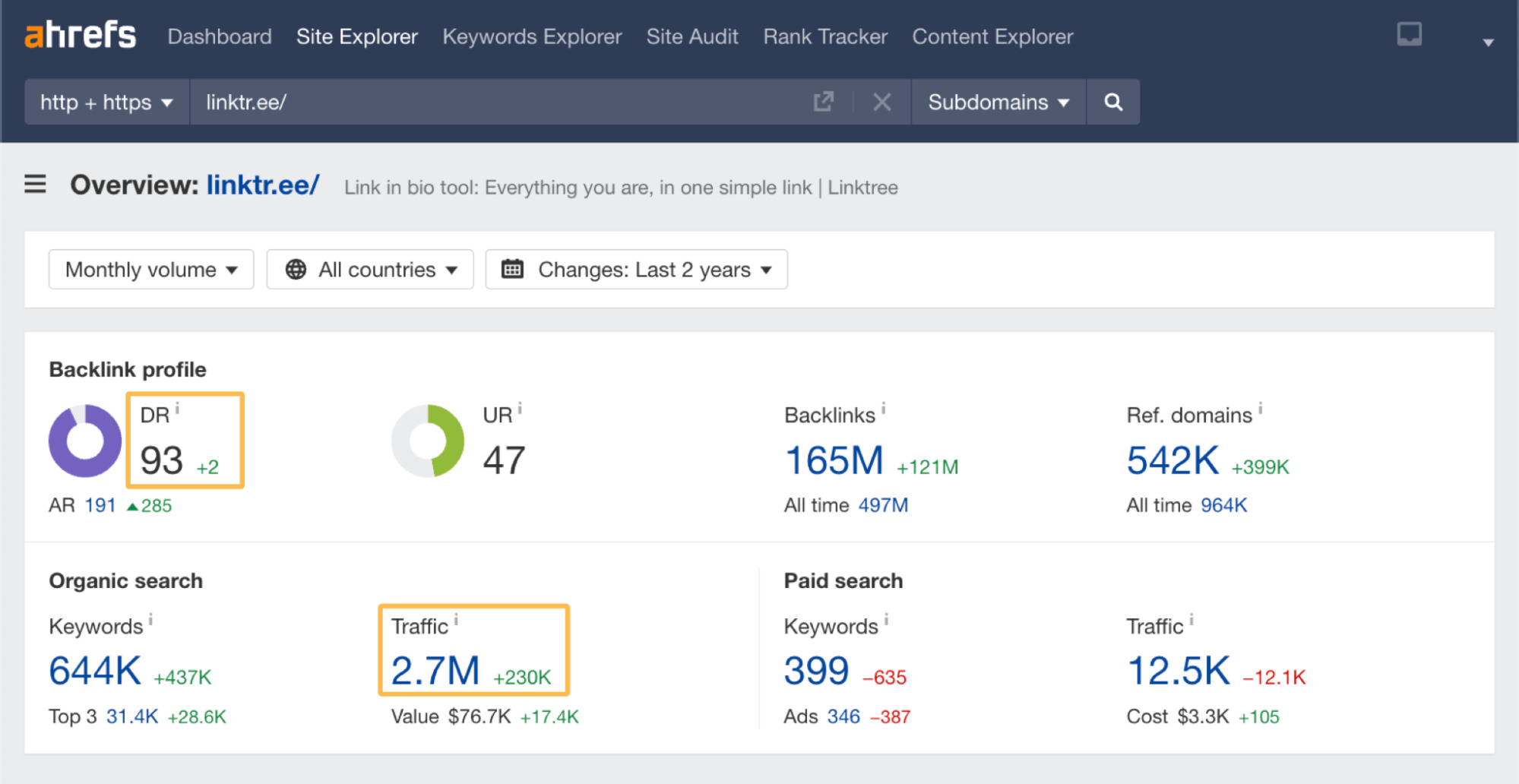
The idea behind Linktree isn’t new—websites like about.me started offering similar products a few years ago.
Linktree grew faster than these platforms, though, once influencers began using it as their preferred link in the bio.
For example, here’s The Rock, Dwayne Johnson, linking to his Linktree account on a major social network—Instagram.

And here’s what his Linktree profile looks like.
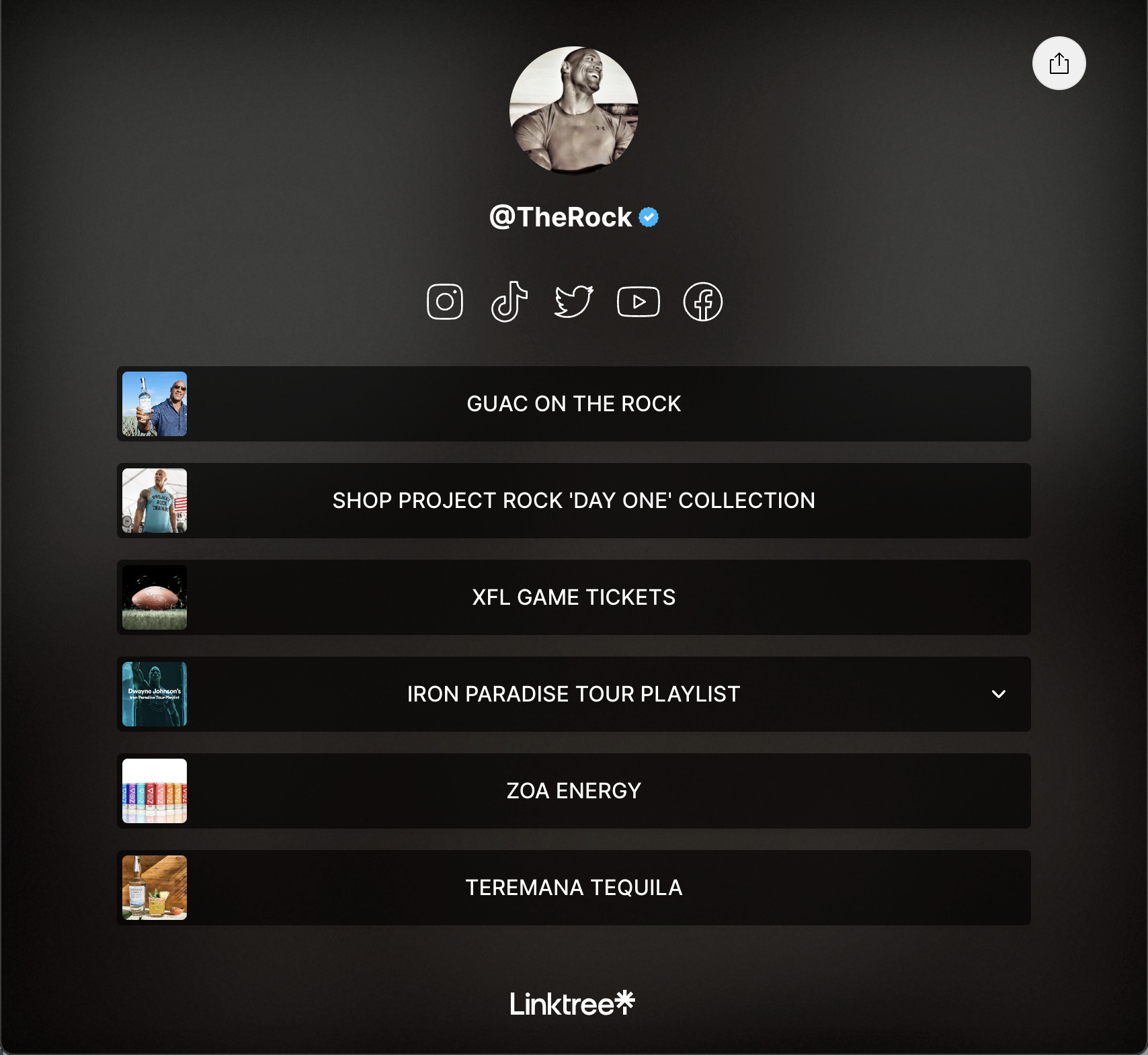
We can see that this content is clear and well presented.
But it’s worth noting that there are only six links to The Rock’s suggested sites, a profile photo, and some social media links—there’s just not much here. And this type of content forms the bulk of Linktree’s pages.
Linktree’s strength is that it solves a pain point of social media for many content creators—you can only have one link on most social media networks.
Another strength is that you don’t need to be a techie to set up a profile, making it attractive to social media influencers.
And as you can see from the screenshots, Linktree has spent a lot of time ensuring the design and user experience are good.
Now that we know a bit about Linktree, let’s look at its organic traffic in Ahrefs’ Site Explorer.
To do this, I’ve entered Linktree’s domain into the search bar, scrolled down to the overview, and selected “Avg. organic traffic.”
We can see the organic traffic rise and fall. Let’s look at the rise first.
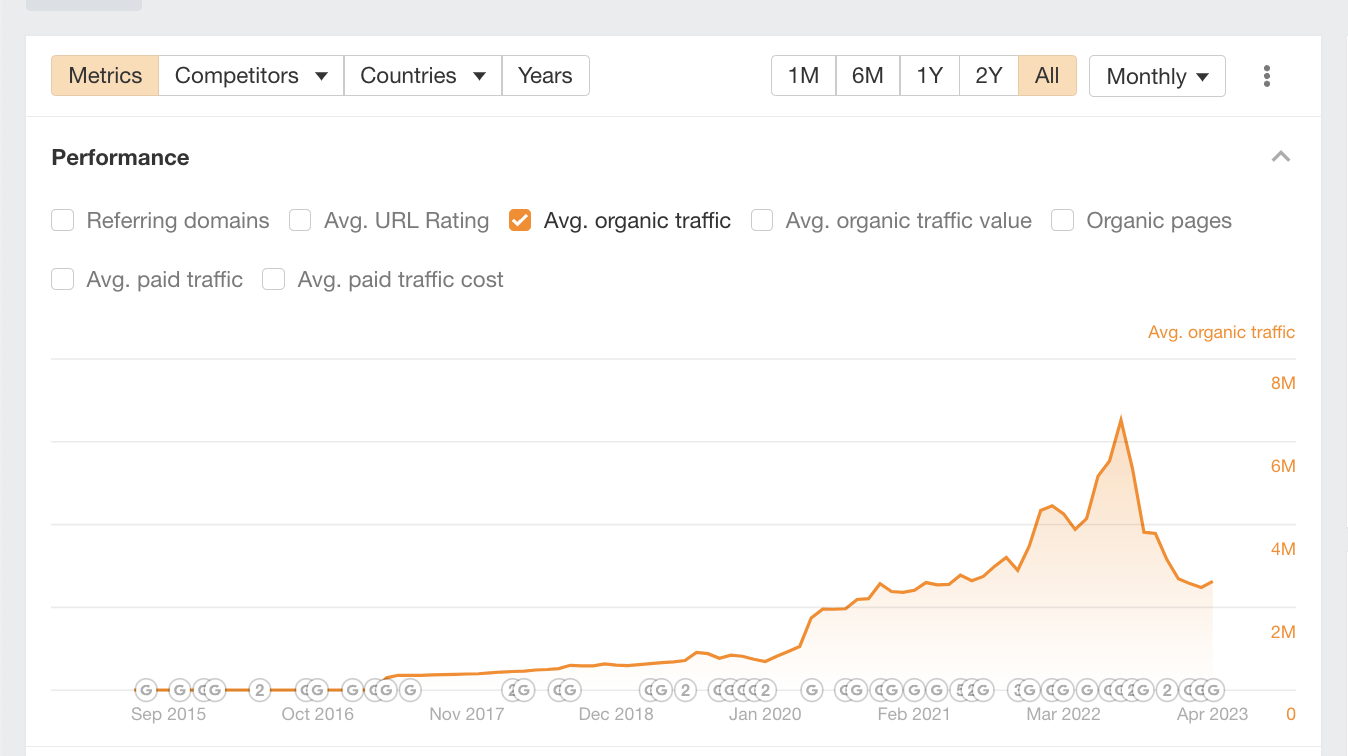
The site had a bump in organic traffic around March–April 2020. The traffic peak was in August 2022, reaching ~6.5 million.
What’s driving the traffic?
If we look at the site in the Top pages report in Site Explorer, we can start to understand where the traffic is coming from.
Let’s start with the basics—we can see that the website has a blog.

We can isolate blog articles using a “URL” filter containing /blog/.

Doing this reveals that the blog has ~500 pages and drives 76,100 organic traffic—a fraction of the overall traffic.
So let’s continue investigating.
Another popular folder in the Top pages report has /s/ in the URL. Let’s see what type of pages we can find.

The /s/ folder pages are general pages explaining Linktree and its services.
These pages drive slightly more traffic than the blog at ~117,000. But again, it’s not that much.
If we remove all the filters, return to the Top pages report, and click the August 22, 2022, performance graph, we can see the most popular pages during this period.
Perhaps, unsurprisingly, most of the top pages appear to be Linktree users’ profile pages.
If we look at the Site structure report in Ahrefs’ Site Explorer, we can confirm this.

Most user profiles follow this format: linktr.ee/username. And we can see, using this report, that most of the traffic is coming from the home folder.
The homepage is also popular. Here, 22.7% of the traffic is going to it.

More interestingly, though, all of the highlighted top pages—or user profiles—have been taken down by Linktree due to “inappropriate use of the service.”
When clicking on these URLs in Ahrefs, I get the image below on Linktree.
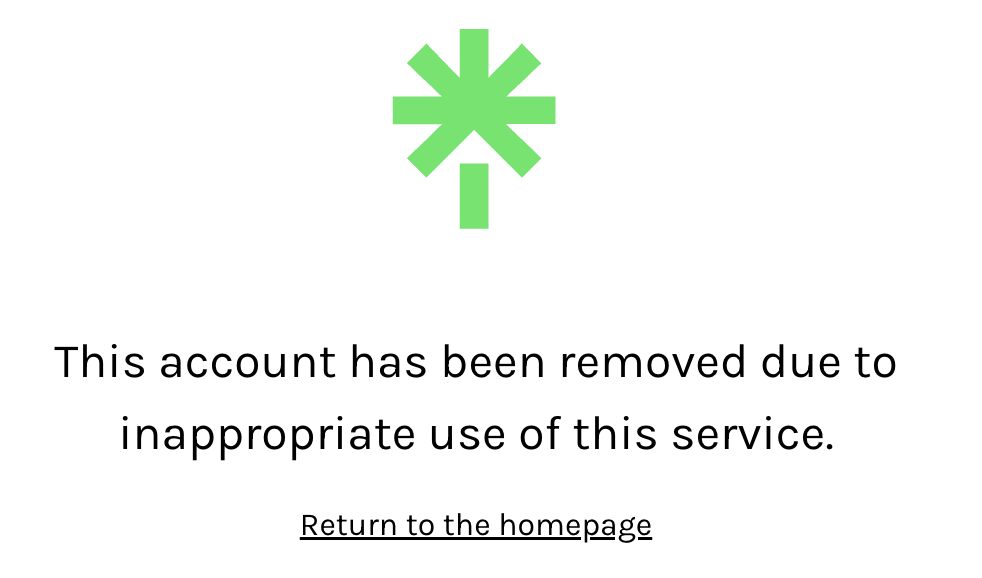
This small sample of pages shows that these profiles collectively drove almost as much organic traffic as the homepage.
So far, we’ve looked at Linktree’s rise. But why has its organic traffic dropped so much?
To understand this, we can compare the peak of Linktree’s organic traffic to the present to see the extent of the banned profiles’ impact on organic traffic.
I’ve added a “Compare” filter in Ahrefs’ Site Explorer to show the extent of the loss.

Using the “Compare” filter, we can see two things:
- The loss of the top traffic-driving profiles has resulted in significantly lower traffic to the site.
- Most of the removed user profiles are from Indonesia.
Traffic by country analysis
To look at the whole website’s traffic, we can look at “Traffic by country” in Site Explorer.

We can see that Indonesia has by far the most significant drop, followed by the United States.
If we click on Indonesia in Site Explorer’s Overview report, it will update the organic traffic graph to only show the organic traffic from that country.
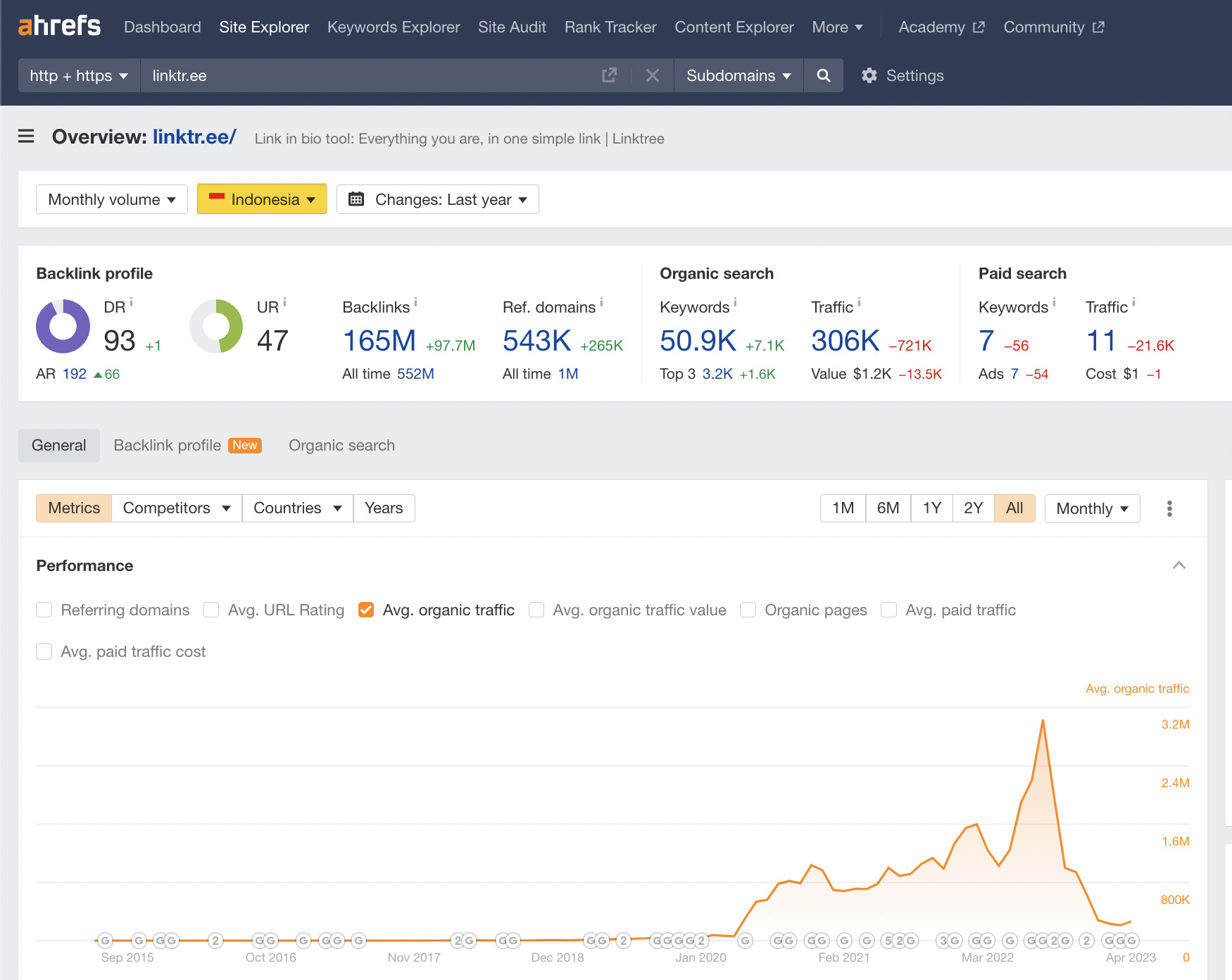
This graph shows that the Indonesian market is primarily responsible for the rise and fall in organic traffic across the site.
So what happened?
My theory: risky (now removed) user profiles were driving the most traffic
Although it’s not clear at this stage why the top profiles were banned, it’s noticeable that most of the remaining top traffic-driving profiles are sharing NSFW links.
For example, here’s what the highest traffic-driving, non-banned user profile looks like:

The majority of links here are for 18+ NSFW content. (My guess is that this is probably not what Linktree wants to be known for.)
Returning to the comparison we ran earlier, we can see that one of the top keywords is “kinghorsetoto.”

Let’s cautiously Google this phrase to see what comes up.

Well, it’s an Indonesian casino site. Given the niche, it’s possible the site violated Linktree’s community standards.
After another search on Google, I discovered this Vice article, which suggested that Linktree removed sex workers from the website in early 2022.
The reason for the ban is explained below:
Per our company’s policies, the Linktree accounts banned stemmed from sharing a URL which violated Community Standards by sharing advertisements for the sale of real-life sexual services.
This ties in with our dates, so it’s possible that these banned profiles are a mix of sex workers’ profiles and anyone else who jeopardizes Linktree’s brand safety, like our Indonesian casino site example.
According to the Vice article, Linktree was popular with sex workers because their content could often be removed from websites without warning, meaning that a third-party site like Linktree would enable them to have multiple backups if their content was removed.
As well as the mass removal of high-traffic user profiles, there also seems to be a correlation with the August 2022 Helpful Content Update.
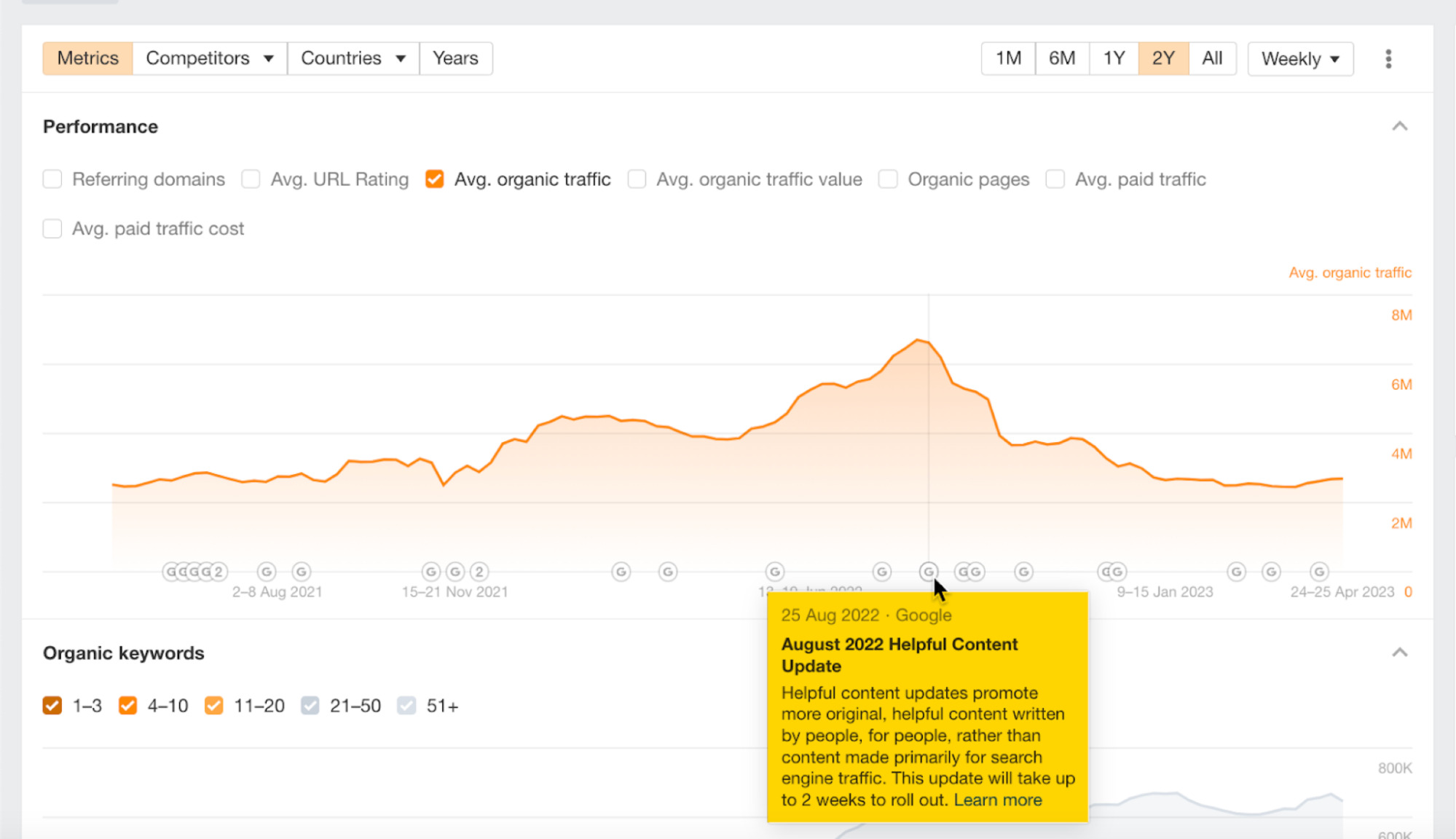
We have seen above that the majority of Linktree’s pages are links to other destinations, with what is, on most pages, minimal content.
Although this content serves the purpose of helping you get from A to B, it may be possible that Google feels this doesn’t fall under its definition of “helpful content.”
Room for improvement in SEO
We’ve looked at some of the bigger factors that could be responsible for Linktree’s recent fall in traffic, but what’s its SEO like?
In my opinion, it looks like Linktree could benefit by improving its SEO basics.
Here are a few examples of things that could be improved:
First, looking at the homepage with Ahrefs’ SEO Toolbar, I found that Linktree appears to not have a sitemap.xml file (at the time of writing).
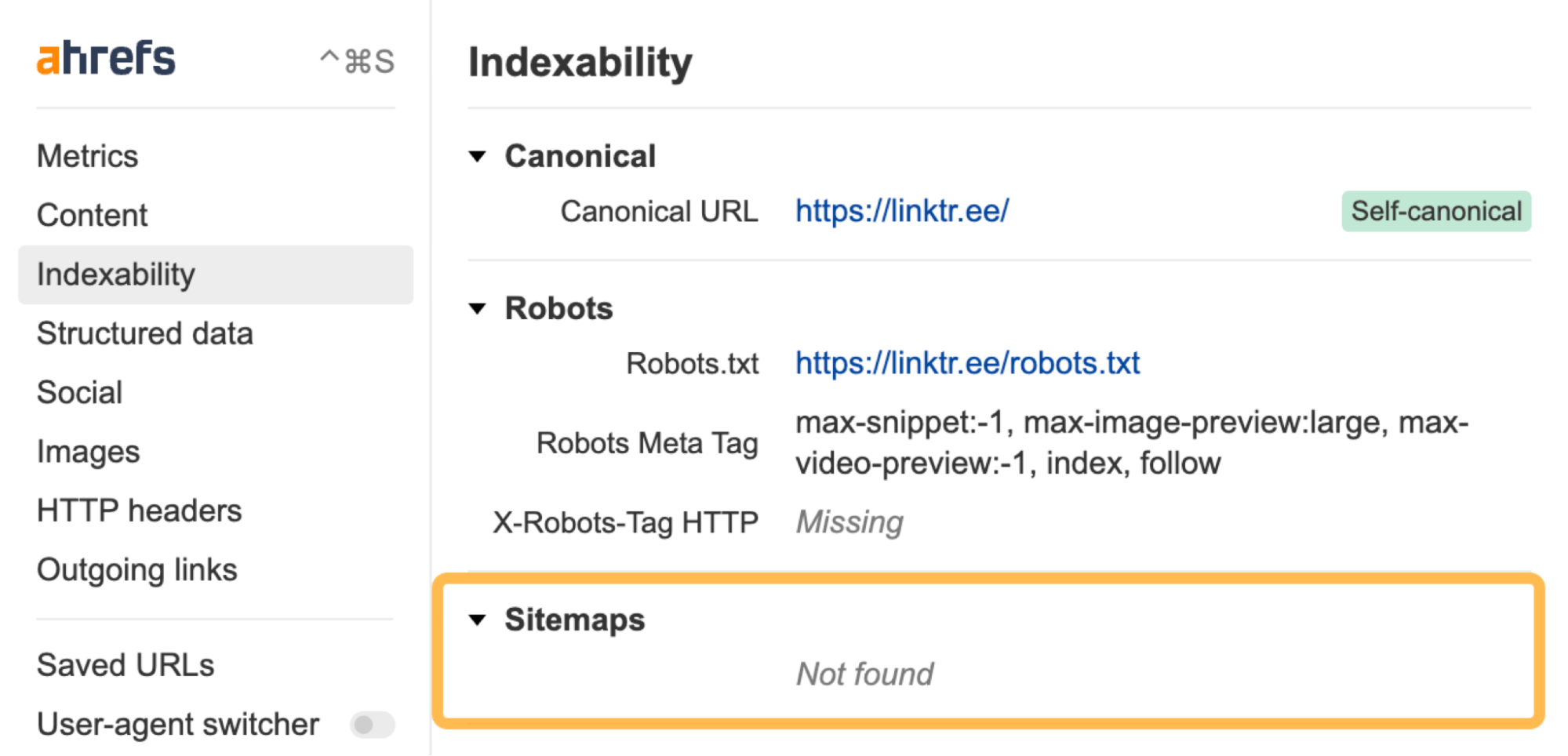
Second, navigating over to the /templates page, you can see that it is using relative URLs for its canonicals.

Although there is nothing technically wrong here, it’s not usually considered best practice to use relative URLs in canonicals, and this has been confirmed by Google’s John Mueller.
Third, clicking around the menu, we can see the /marketplace page lacks a canonical tag completely. (This could be by design, but it seems a little odd to me if that is the case.)

Also, the “Discover” menu links to pages with “noindex, nofollow.”
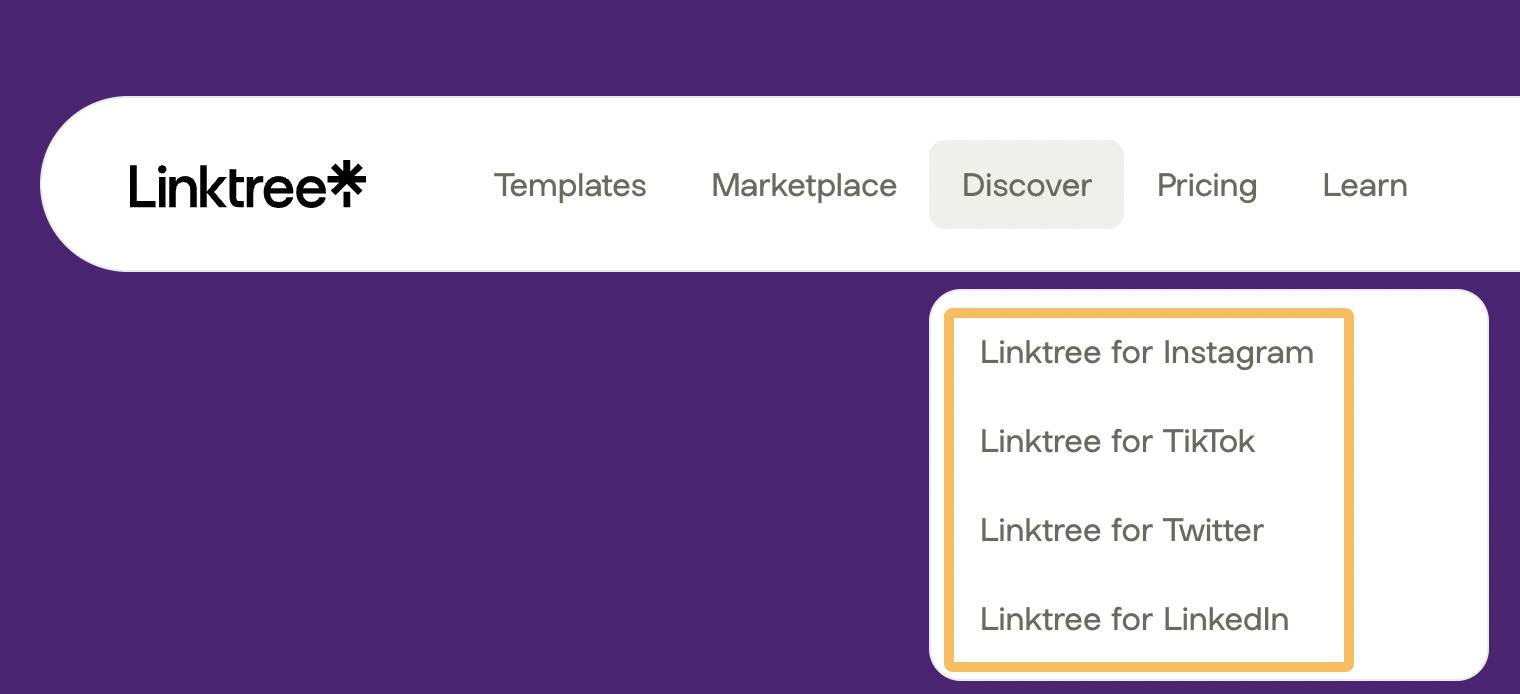
We can confirm this if we use the SEO Toolbar.

Setting a page to “noindex, nofollow” means that all search engines won’t be able to index this page. Again, it’s not particularly obvious why it did this.
It’s clear there are a few issues to look at here on a quick spot-check. But if we wanted to discover all of this site’s issues, we would need to run an audit using Ahrefs’ Site Audit.
Prioritizing design over SEO?
In terms of the look and feel of the site, it’s clear that Linktree has put a lot of effort into this aspect.
The site looks great. The design may have even inspired Wise’s most recent redesign. (Sadly, though, Google doesn’t rank sites based on the quality of the design.)

The future for Linktree in terms of organic traffic feels uncertain at the moment. But with a bit of work on the SEO basics, it could be improved.
Increased competition
Another factor to consider is that Linktree will face increased competition from big social networks. For example, recently, Instagram has added support for up to five links in the bio.

Although this doesn’t destroy Linktree’s business model, it may mean it loses some users who feel safer staying within the Instagram ecosystem.
Saying that, it hasn’t gone unnoticed by the Linktree Tiktok staff that Meta is still using a Linktree in its bio.
Another factor to consider is its smaller competitors—there are many of them now:
- later.com/link-in-bio/
- lnk.bio
- shor.by
- tap.bio
- feedlink.io
- linkinprofile.com
- milkshake.app
- campsite.bio
- bio.fm
- url.bio
- biolincs.me
- beacons.ai
Most offer a similar service to Linktree, so it must differentiate itself from its competitors moving forward, in my opinion.
How worried should it be about these smaller competitors? At the moment, not much.
If we put some of them into Site Explorer’s Organic competitors report, we can see that Linktree is way ahead of these smaller competitors in terms of organic traffic and organic traffic value.

When it comes to other marketing channels, we can see it already has an active presence on TikTok. This may be considered more important to its business than SEO.
But saying that, at the time of writing, it appears that Linktree is looking to hire a new senior SEO strategist. So it is aware of the need for SEO.
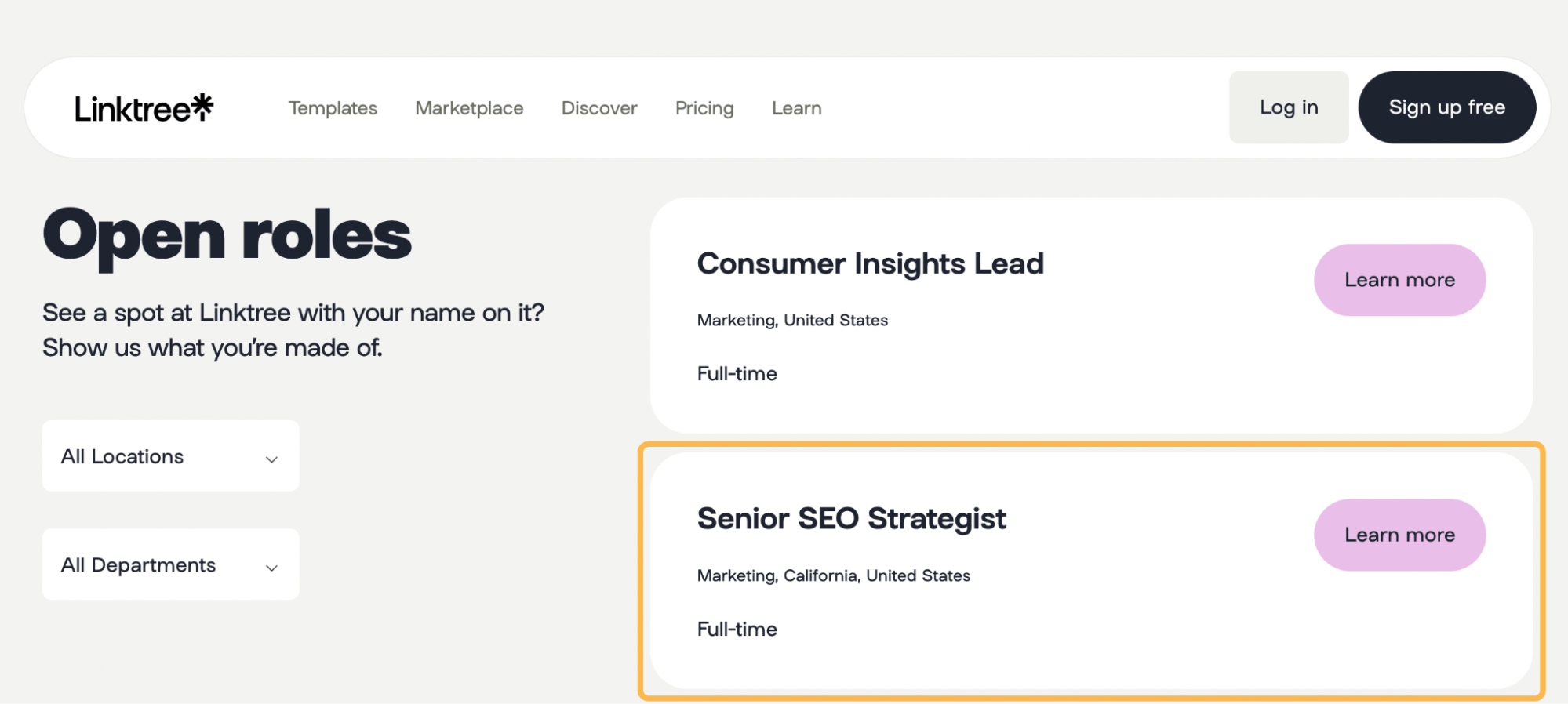
Maybe a renewed focus on SEO is on the cards for the future?
Final thoughts
SEO is a funny old world. When I started this case study, I didn’t expect to be writing about sex workers and Indonesian casino websites. But here we are.
Linktree’s SEO needs a bit of a spring clean. But as we’ve seen, the main fall in traffic is likely self-inflicted and due to the removal of “top traffic” user profiles.
Got more questions? Ping me on Twitter. 🙂
SEO
Google Further Postpones Third-Party Cookie Deprecation In Chrome

Google has again delayed its plan to phase out third-party cookies in the Chrome web browser. The latest postponement comes after ongoing challenges in reconciling feedback from industry stakeholders and regulators.
The announcement was made in Google and the UK’s Competition and Markets Authority (CMA) joint quarterly report on the Privacy Sandbox initiative, scheduled for release on April 26.
Chrome’s Third-Party Cookie Phaseout Pushed To 2025
Google states it “will not complete third-party cookie deprecation during the second half of Q4” this year as planned.
Instead, the tech giant aims to begin deprecating third-party cookies in Chrome “starting early next year,” assuming an agreement can be reached with the CMA and the UK’s Information Commissioner’s Office (ICO).
The statement reads:
“We recognize that there are ongoing challenges related to reconciling divergent feedback from the industry, regulators and developers, and will continue to engage closely with the entire ecosystem. It’s also critical that the CMA has sufficient time to review all evidence, including results from industry tests, which the CMA has asked market participants to provide by the end of June.”
Continued Engagement With Regulators
Google reiterated its commitment to “engaging closely with the CMA and ICO” throughout the process and hopes to conclude discussions this year.
This marks the third delay to Google’s plan to deprecate third-party cookies, initially aiming for a Q3 2023 phaseout before pushing it back to late 2024.
The postponements reflect the challenges in transitioning away from cross-site user tracking while balancing privacy and advertiser interests.
Transition Period & Impact
In January, Chrome began restricting third-party cookie access for 1% of users globally. This percentage was expected to gradually increase until 100% of users were covered by Q3 2024.
However, the latest delay gives websites and services more time to migrate away from third-party cookie dependencies through Google’s limited “deprecation trials” program.
The trials offer temporary cookie access extensions until December 27, 2024, for non-advertising use cases that can demonstrate direct user impact and functional breakage.
While easing the transition, the trials have strict eligibility rules. Advertising-related services are ineligible, and origins matching known ad-related domains are rejected.
Google states the program aims to address functional issues rather than relieve general data collection inconveniences.
Publisher & Advertiser Implications
The repeated delays highlight the potential disruption for digital publishers and advertisers relying on third-party cookie tracking.
Industry groups have raised concerns that restricting cross-site tracking could push websites toward more opaque privacy-invasive practices.
However, privacy advocates view the phaseout as crucial in preventing covert user profiling across the web.
With the latest postponement, all parties have more time to prepare for the eventual loss of third-party cookies and adopt Google’s proposed Privacy Sandbox APIs as replacements.
Featured Image: Novikov Aleksey/Shutterstock
SEO
How To Write ChatGPT Prompts To Get The Best Results

ChatGPT is a game changer in the field of SEO. This powerful language model can generate human-like content, making it an invaluable tool for SEO professionals.
However, the prompts you provide largely determine the quality of the output.
To unlock the full potential of ChatGPT and create content that resonates with your audience and search engines, writing effective prompts is crucial.
In this comprehensive guide, we’ll explore the art of writing prompts for ChatGPT, covering everything from basic techniques to advanced strategies for layering prompts and generating high-quality, SEO-friendly content.
Writing Prompts For ChatGPT
What Is A ChatGPT Prompt?
A ChatGPT prompt is an instruction or discussion topic a user provides for the ChatGPT AI model to respond to.
The prompt can be a question, statement, or any other stimulus to spark creativity, reflection, or engagement.
Users can use the prompt to generate ideas, share their thoughts, or start a conversation.
ChatGPT prompts are designed to be open-ended and can be customized based on the user’s preferences and interests.
How To Write Prompts For ChatGPT
Start by giving ChatGPT a writing prompt, such as, “Write a short story about a person who discovers they have a superpower.”
ChatGPT will then generate a response based on your prompt. Depending on the prompt’s complexity and the level of detail you requested, the answer may be a few sentences or several paragraphs long.
Use the ChatGPT-generated response as a starting point for your writing. You can take the ideas and concepts presented in the answer and expand upon them, adding your own unique spin to the story.
If you want to generate additional ideas, try asking ChatGPT follow-up questions related to your original prompt.
For example, you could ask, “What challenges might the person face in exploring their newfound superpower?” Or, “How might the person’s relationships with others be affected by their superpower?”
Remember that ChatGPT’s answers are generated by artificial intelligence and may not always be perfect or exactly what you want.
However, they can still be a great source of inspiration and help you start writing.
Must-Have GPTs Assistant
I recommend installing the WebBrowser Assistant created by the OpenAI Team. This tool allows you to add relevant Bing results to your ChatGPT prompts.
This assistant adds the first web results to your ChatGPT prompts for more accurate and up-to-date conversations.
It is very easy to install in only two clicks. (Click on Start Chat.)
For example, if I ask, “Who is Vincent Terrasi?,” ChatGPT has no answer.
With WebBrower Assistant, the assistant creates a new prompt with the first Bing results, and now ChatGPT knows who Vincent Terrasi is.
 Screenshot from ChatGPT, March 2023
Screenshot from ChatGPT, March 2023You can test other GPT assistants available in the GPTs search engine if you want to use Google results.
Master Reverse Prompt Engineering
ChatGPT can be an excellent tool for reverse engineering prompts because it generates natural and engaging responses to any given input.
By analyzing the prompts generated by ChatGPT, it is possible to gain insight into the model’s underlying thought processes and decision-making strategies.
One key benefit of using ChatGPT to reverse engineer prompts is that the model is highly transparent in its decision-making.
This means that the reasoning and logic behind each response can be traced, making it easier to understand how the model arrives at its conclusions.
Once you’ve done this a few times for different types of content, you’ll gain insight into crafting more effective prompts.
Prepare Your ChatGPT For Generating Prompts
First, activate the reverse prompt engineering.
- Type the following prompt: “Enable Reverse Prompt Engineering? By Reverse Prompt Engineering I mean creating a prompt from a given text.”
 Screenshot from ChatGPT, March 2023
Screenshot from ChatGPT, March 2023ChatGPT is now ready to generate your prompt. You can test the product description in a new chatbot session and evaluate the generated prompt.
- Type: “Create a very technical reverse prompt engineering template for a product description about iPhone 11.”
 Screenshot from ChatGPT, March 2023
Screenshot from ChatGPT, March 2023The result is amazing. You can test with a full text that you want to reproduce. Here is an example of a prompt for selling a Kindle on Amazon.
- Type: “Reverse Prompt engineer the following {product), capture the writing style and the length of the text :
product =”
 Screenshot from ChatGPT, March 2023
Screenshot from ChatGPT, March 2023I tested it on an SEJ blog post. Enjoy the analysis – it is excellent.
- Type: “Reverse Prompt engineer the following {text}, capture the tone and writing style of the {text} to include in the prompt :
text = all text coming from https://www.searchenginejournal.com/google-bard-training-data/478941/”
 Screenshot from ChatGPT, March 2023
Screenshot from ChatGPT, March 2023But be careful not to use ChatGPT to generate your texts. It is just a personal assistant.
Go Deeper
Prompts and examples for SEO:
- Keyword research and content ideas prompt: “Provide a list of 20 long-tail keyword ideas related to ‘local SEO strategies’ along with brief content topic descriptions for each keyword.”
- Optimizing content for featured snippets prompt: “Write a 40-50 word paragraph optimized for the query ‘what is the featured snippet in Google search’ that could potentially earn the featured snippet.”
- Creating meta descriptions prompt: “Draft a compelling meta description for the following blog post title: ’10 Technical SEO Factors You Can’t Ignore in 2024′.”
Important Considerations:
- Always Fact-Check: While ChatGPT can be a helpful tool, it’s crucial to remember that it may generate inaccurate or fabricated information. Always verify any facts, statistics, or quotes generated by ChatGPT before incorporating them into your content.
- Maintain Control and Creativity: Use ChatGPT as a tool to assist your writing, not replace it. Don’t rely on it to do your thinking or create content from scratch. Your unique perspective and creativity are essential for producing high-quality, engaging content.
- Iteration is Key: Refine and revise the outputs generated by ChatGPT to ensure they align with your voice, style, and intended message.
Additional Prompts for Rewording and SEO:
– Rewrite this sentence to be more concise and impactful.
– Suggest alternative phrasing for this section to improve clarity.
– Identify opportunities to incorporate relevant internal and external links.
– Analyze the keyword density and suggest improvements for better SEO.
Remember, while ChatGPT can be a valuable tool, it’s essential to use it responsibly and maintain control over your content creation process.
Experiment And Refine Your Prompting Techniques
Writing effective prompts for ChatGPT is an essential skill for any SEO professional who wants to harness the power of AI-generated content.
Hopefully, the insights and examples shared in this article can inspire you and help guide you to crafting stronger prompts that yield high-quality content.
Remember to experiment with layering prompts, iterating on the output, and continually refining your prompting techniques.
This will help you stay ahead of the curve in the ever-changing world of SEO.
More resources:
Featured Image: Tapati Rinchumrus/Shutterstock
SEO
Measuring Content Impact Across The Customer Journey

Understanding the impact of your content at every touchpoint of the customer journey is essential – but that’s easier said than done. From attracting potential leads to nurturing them into loyal customers, there are many touchpoints to look into.
So how do you identify and take advantage of these opportunities for growth?
Watch this on-demand webinar and learn a comprehensive approach for measuring the value of your content initiatives, so you can optimize resource allocation for maximum impact.
You’ll learn:
- Fresh methods for measuring your content’s impact.
- Fascinating insights using first-touch attribution, and how it differs from the usual last-touch perspective.
- Ways to persuade decision-makers to invest in more content by showcasing its value convincingly.
With Bill Franklin and Oliver Tani of DAC Group, we unravel the nuances of attribution modeling, emphasizing the significance of layering first-touch and last-touch attribution within your measurement strategy.
Check out these insights to help you craft compelling content tailored to each stage, using an approach rooted in first-hand experience to ensure your content resonates.
Whether you’re a seasoned marketer or new to content measurement, this webinar promises valuable insights and actionable tactics to elevate your SEO game and optimize your content initiatives for success.
View the slides below or check out the full webinar for all the details.
-

 PPC6 days ago
PPC6 days ago19 Best SEO Tools in 2024 (For Every Use Case)
-

 MARKETING7 days ago
MARKETING7 days agoEcommerce evolution: Blurring the lines between B2B and B2C
-
SEARCHENGINES5 days ago
Daily Search Forum Recap: April 19, 2024
-
SEARCHENGINES6 days ago
Daily Search Forum Recap: April 18, 2024
-

 WORDPRESS6 days ago
WORDPRESS6 days agoHow to Make $5000 of Passive Income Every Month in WordPress
-

 SEO7 days ago
SEO7 days ago2024 WordPress Vulnerability Report Shows Errors Sites Keep Making
-

 WORDPRESS6 days ago
WORDPRESS6 days ago10 Amazing WordPress Design Resouces – WordPress.com News
-
WORDPRESS7 days ago
[GET] The7 Website And Ecommerce Builder For WordPress
















